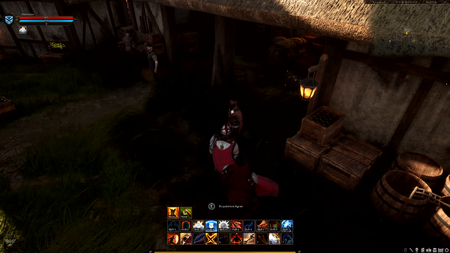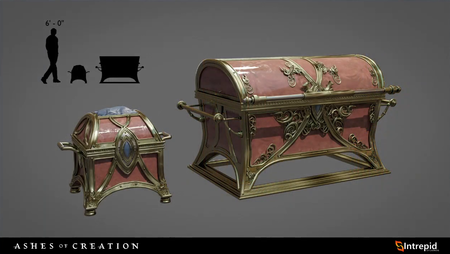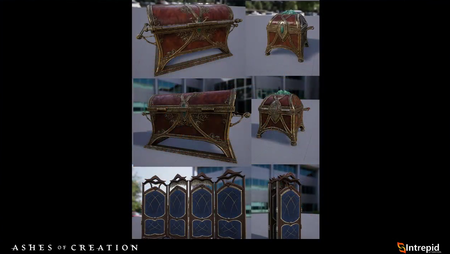Warehouses
Warehouses are default service buildings that come pre-built with nodes. Their function is to provide storage points within nodes.[2][3][4][5][6][7]
- Cargo for shipment by caravan is stored at the caravansary not in a player's inventory. Stored cargo is visible via the warehouse UI.[8][9]
- Completed items can be accessed by players in warehouses at any node regardless of citizenship or housing ownership.[10][11][12]
- Gatherables and materials may only be accessed in the warehouse location they were deposited in.[13]
- Requisition agents for mayoral buy orders are located at node warehouses.[1]
- Players are prohibited from moving gatherables, materials, and commodities in sealed crates out of depositories within a node following a siege declaration against that node.[13][14][15][7]
- A portion of all gatherables and materials that were stored in successfully sieged nodes become lootable.[16][17][18][6][7][19]
- Whole items (crafted items) are not vulnerable to loss during node sieges.[20]
- Corrupt players are not able to utilize storage systems.[21][22][23]
- Player stalls are linked to that player's warehouse.[20]
- Personal caravans may be launched from any point of storage (including warehouses).[24]
Unloading cargo
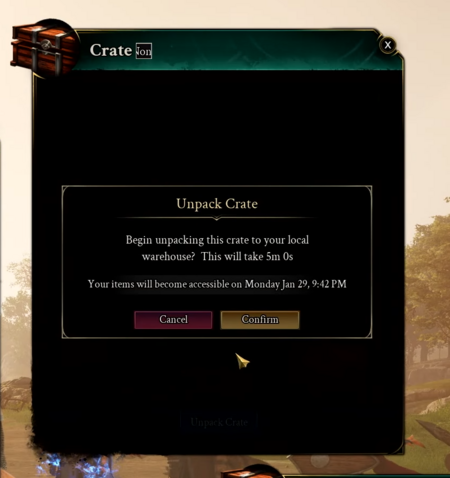
That timer scales with how the node progresses. That's actually an extremely fast unpacking time, but typically it's going to be on the scale of days.[25] – John Collins
Materials crates that are transported by caravans (or merchant ships) may be unloaded into a node's warehouse.[25]
- Unpacking time can take a number of IRL days to complete. This can be decreased through node policies, service building upgrades, and node progression.[26][25]
- That throttle of timing out the unloading of materials and supplies is intended to mitigate the impact on the local economy that transiting materials has within the world. Right now that's a runway, which means that through certain decisions that a node makes, whether it be upgrades or policies, they can reduce that amount of time significantly; and by creating a differential or a disparity of the amount that days would represent, versus hours, you can have the nodes that select those types of upgrades and policies really become the epicenter of trade within a particular region.[26] – Steven Sharif
- Player commodities may be sold directly from caravan (or merchant ship) inventory to commodities vendors.[25]
Storage
Storage points exist at warehouses within nodes and in chests (storage containers) that can be placed in freeholds and static in-node housing.[28][4][29]
- Sheds are present on empty freehold plots to provide basic storage for materials needed to construct freehold buildings.[30]
Player housing storage
Chests are a type of furniture that provides localized storage within a specific house.[32][33][34]
- Players must obtain and place storage containers in their player-owned housing.[33]
- Different grades of storage containers have different inventory capacities.[33]
- There are restrictions on the grades of storage containers available in different types of houses.[33]
- Access permissions can be set to allow others to access a player's personal storage devices.[32][35][36][37]
- Personal storage chests may be set to permit access by family or guild members.[36][38]
- Transfer of resources and materials to alts will only be possible via player housing storage, as this is local to the specific house.[32]
- Players are prohibited from moving goods out of depositories within a node following a siege declaration against that node.[7]
- Gatherables and crafting materials that were stored in in-node housing and apartment storage chests become lootable upon a successful siege against the parent node. These do not become lootable if the node survives the siege- even if the housing buildings are destroyed or damaged during the siege.[6]
- Corrupt players are not able to utilize storage systems.[21][22][23]
- Personal caravans may be launched from any point of storage (including chests).[24]
Requisition agents
Requisition agents are NPCs that enable players to fulfill buy orders.[1]
- Requisition agents are located at the warehouse default service building in nodes.[1]
Banking
Nodes advance to the first stage quickly. This enables NPC services such as vending or banking items.[39]
- Banking between characters will likely be restricted to furniture and completed items.[37]
- A warehouse ability may enable a player to transfer non-material goods between alternate characters. This excludes resources, materials or anything that relies on the caravan system.[5]
Mailing items
- Raw gatherables and materials are not able to be mailed by players.[40][41][42]
- Purchases of anything other than materials and gatherables from integrated auction houses will be mailed to the purchaser.[43]
- Social messages sent via mail will be received instantly.[40]
- It hasn't been decided whether crafted items such as gear will be able to be sent via mail.[40]
- From an item standpoint obviously we can't allow mailing to include any type of resource material or raw gatherable because those are central to the gameplay and transiting through the caravan system and economic regions. But it may be possible to send completed crafted items like gear, equipment, stuff like that. But it's something we're still discussing.[40] – Steven Sharif
Player inventory
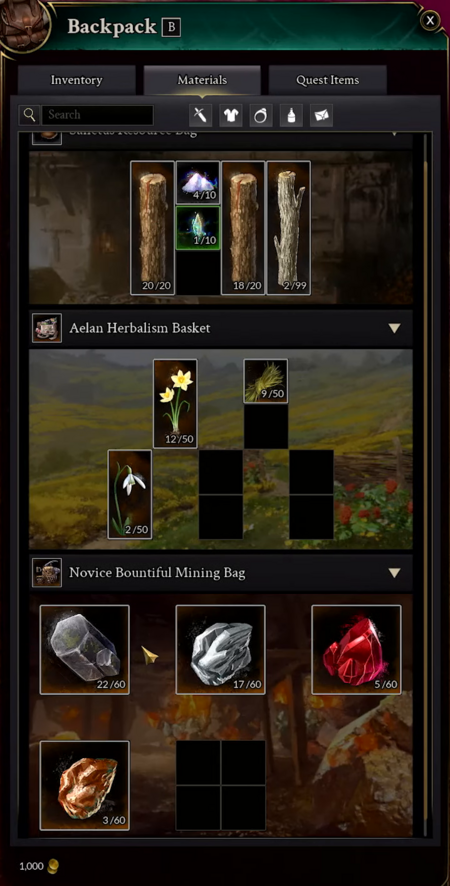
Inventory for A2 will exist in two categories, spatial and non-spatial. The spatial inventory system will only exist for materials and gatherables. The non-spatial system will be the normal single slot inventory that is used for all completed items IE gear, consumables etc.. The spatial system is intended to provide limitation and progression when everything in the open world is gatherable, requiring players to strategize which things they choose to gather or not. These spatial inventories will be shaped in various ways that make the bag types more conducive for certain types of gatherables allowing players to specialize their capacity. Auto sort is a feature[45] – Steven Sharif
Inventory capacity has quantity (stacking) limits based on the type of item.[46][47] Backpacks offer varying stack sizes and/or spatial inventory shapes that are optimized for carrying different items.[48][49]
- A player's inventory has sections for different types of items.[50] Quest items for example will not fill a player's regular inventory capacity.[51]
- Materials and resource bags have spatial ("Tetris" style) slots for items with different shapes and sizes.[52][45][53][54][55]
- The spatial inventory system is intended to mitigate the potential for players to diminish land management scores by stripping resources from particular zones as well as provide a challenging gameplay layer for players.[52][56]
- Inventory is split into two separate management systems. The first is your non-material, non-gatherable slots. Those are your standard single slot, not-space-constrained system that's a standard inventory: you just have a single slot, and you can pull completed items and/or consumables and quest items or whatever into that slot. And then, when you're talking about materials, specifically processed goods and gatherables: those exist within the Tetris type uh inventory system.[53] – Steven Sharif
- All those materials actually sorted nicely in the appropriate bags based on your stack sizes.[44] – Alex Khudoliy
- There will be a healthy number of slots for gear in a player's inventory.[12]
- Completed item inventory slots are not space constrained (by the tetris system).[53]
- Completed items, such as gear are also not subject to weight limits.[12]
- Gear loadouts can be swapped using a hotkey when out of combat.[12][57][58]
- Inventory capacity will be relatively limited for new characters.[51] Additional capacity may be increased by obtaining higher quality backpacks from crafters.[59][53][46]
- We want to have very unique progression when it comes to the construction of resource bags; and those resource bags will have certain benefits, like increasing stack size count of particular types of resources; or of having a additional delay time necessary to interface with with your corpse, should a player try to take the resources you might have dropped in PvP; or having passive benefits and unique structures of spacing that makes it more a better bag for wood gathering because woods are three-by-one; or a better bag for mining because mining is always two-by-two. The idea is to make your intent as a gatherer when you go out into the wild specific right not just that you're going out into the wild and gathering everything you can because it's there; and that's what we don't have like a labor system that limits it. We have a space constraint system so when you leave your node and you go out into the wild you need to be conscientious of what you're choosing to interact with and take resources for, because you have a limited space constraint to that degree.[53] – Steven Sharif
- Inventory capacity is subject to quantity rather than weight limits.[46]
- In my opinion, and this is of course subjective, but weight management is not a compelling mechanic for players to have to deal with in an MMO setting.[46] – Steven Sharif
- Players will have the ability to search for items they have stored in various locations (such as personal storage and node warehouses).[60]
- We want you to know where the things are; and then the meaningful aspect of that thing is traveling to those locations to access some of those things, particularly as it relates to materials and raw gatherables.[60] – Steven Sharif
- Inventories will be able to be sorted.[45]
- Q: Why did you go for a spatial inventory system for resources?
- A: There's a number of different methods that we can use in an effort to mitigate, or again throttle, the amount of success that players can have in any one trip out in the world. Now, we're using a combination of three things: We are using progression gating through your profession level; so you need to have a certain level to access certain resources. We are utilizing the spatial inventory space as a limitation on how much things you can gather before you need to go back to town. And then lastly we have a tool predicate where you need to have a tool that is relevant for the resource you're gathering; and those tools have a decay value after each use. Weight is obviously an approach that we could take if we wanted to limit. However, the spatial system works in concert with a number of other types of systems. For example, we want to have itemization drop on death specifically as it relates to material items; and we want there to be an additional layer above just weight that introduces complexity; and where there is complexity there is choice and there is strategy and there is planning required on behalf of the player in order to set themselves up for the best possible success in certain situations.[52] – Steven Sharif
- Mules can carry roughly 10 times more than backpacks. Caravans can carry roughly 10 times more than mules.[61]
- Inventory expansion and weight management training certificates are available in the Galleria at City stage economic nodes.[51][62]
Visuals
See also
References
- ↑ 1.0 1.1 1.2 1.3 1.4 1.5 Video, August 31, 2023 (25:00).
- ↑ Blog: Development Update with Village Node.
- ↑ Livestream, August 31, 2023 (50:25).
- ↑ 4.0 4.1 Interview, December 6, 2018 (20:30).
- ↑ 5.0 5.1 5.2 Livestream, 2018-04-8 (AM) (23:18).
- ↑ 6.0 6.1 6.2 Interview, July 8, 2020 (57:46).
- ↑ 7.0 7.1 7.2 7.3 Livestream, April 30, 2020 (1:14:44).
- ↑

- ↑ Livestream, October 31, 2023 (1:08:57).
- ↑

- ↑

- ↑ 12.0 12.1 12.2 12.3 Interview, September 10, 2023 (47:13).
- ↑ 13.0 13.1

- ↑ Livestream, October 30, 2020 (1:03:52).
- ↑ Interview, July 19, 2020 (41:32).
- ↑ Interview, July 9, 2023 (1:36:24).
- ↑ Livestream, October 14, 2022 (52:31).
- ↑ Podcast, September 29, 2021 (14:21).
- ↑

- ↑ 20.0 20.1 Livestream, October 30, 2020 (1:04:59).
- ↑ 21.0 21.1 Livestream, February 24, 2023 (1:12:24).
- ↑ 22.0 22.1 Livestream, October 28, 2022 (24:28).
- ↑ 23.0 23.1 Livestream, April 30, 2021 (1:14:49).
- ↑ 24.0 24.1

- ↑ 25.0 25.1 25.2 25.3 25.4 Video, January 31, 2024 (32:03).
- ↑ 26.0 26.1 Livestream, January 31, 2024 (1:10:33).
- ↑ Video, January 31, 2024 (31:05).
- ↑ 28.0 28.1 Video, June 30, 2023 (19:20).
- ↑ Video, May 31, 2020 (47:32).
- ↑ Livestream, June 30, 2023 (18:45).
- ↑ 31.0 31.1 Livestream, June 25, 2021 (22:34).
- ↑ 32.0 32.1 32.2 Livestream, July 30, 2021 (1:14:33).
- ↑ 33.0 33.1 33.2 33.3 Video, May 31, 2020 (47:32).
- ↑ Livestream, August 17, 2018 (10:54).
- ↑ Livestream, April 30, 2021 (1:12:33).
- ↑ 36.0 36.1 Livestream, June 26, 2020 (51:58).
- ↑ 37.0 37.1 Livestream, June 28, 2019 (1:23:31).
- ↑

- ↑
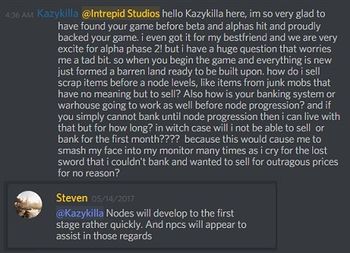
- ↑ 40.0 40.1 40.2 40.3 Livestream, January 29, 2021 (1:14:53).
- ↑ Video, September 6, 2018 (3:53).
- ↑ Livestream, July 9, 2018 (50:16).
- ↑

- ↑ 44.0 44.1 44.2 Video, November 30, 2023 (30:19).
- ↑ 45.0 45.1 45.2 Twitter - Steven Sharif - Spatial inventory slots.
- ↑ 46.0 46.1 46.2 46.3 Livestream, February 24, 2023 (54:55).
- ↑ Livestream, May 29, 2020 (1:27:18).
- ↑ Video, November 30, 2023 (13:38).
- ↑

- ↑ Livestream, February 24, 2023 (22:57).
- ↑ 51.0 51.1 51.2 Livestream, July 25, 2020 (1:14:13).
- ↑ 52.0 52.1 52.2 Livestream, November 30, 2023 (1:29:18).
- ↑ 53.0 53.1 53.2 53.3 53.4 Livestream, June 30, 2023 (1:24:42).
- ↑ Livestream, June 30, 2023 (46:17).
- ↑ Video, June 30, 2023 (8:54).
- ↑ Podcast, July 15, 2023 (22:57).
- ↑ Livestream, February 24, 2023 (46:15).
- ↑ Livestream, November 19, 2021 (40:53).
- ↑ Livestream, November 30, 2023 (1:34:08).
- ↑ 60.0 60.1 Livestream, July 29, 2022 (1:17:33).
- ↑ Livestream, July 18, 2017 (44:57).
- ↑ Know Your Nodes: Economic Node Type.
